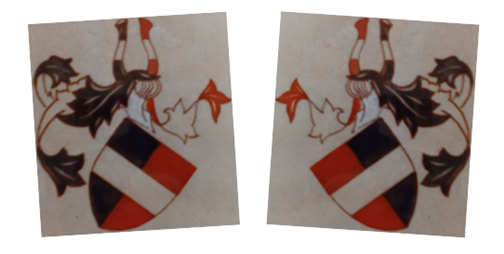
until ~1450 / >1500
LOCHNER OF WAISCHENFELD
LOCHNER OF LIEBENFELS – Carinthia – Austria
The Lochner of Waischenfeld (city next to Bayreuth) start even with Rupprecht Lochner, the first secured Kastner of the Lochners (explanation: see below). His father could be Hans III Lochner – he is mentioned in documents from Ebermannstadt in 1410. The latest evidence suggests that the Waischenfeld line and its cadet line, the Lochner of Liebenfels in Carinthia, Austria, have adapted the coat-of-arms variant of the “red” Lochner branches before 1500. They seem to have acted more class-consciously than their closer relatives in Ebermannstadt (see: 03 LVE HISTORY). Women’s surnames are rare before 1400 A.D., but Rupprecht Lochner’s wife is actually known by her full name. Anna Ermreicher named Tetzel (also Tetzlein – coat-of-arms: Muehlstein (=mill-stone) – side-line: Tuerkelsteiner).
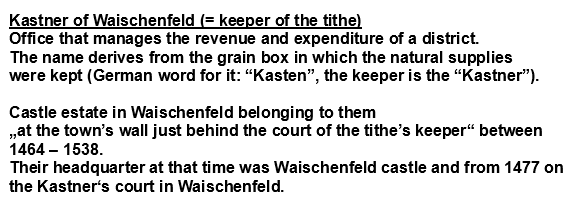
The line of ancestors of the Ermreicher begins in 1317: Zoggendorf Castle near Heiligenstadt in Franconian Switzerland[1] has been built by them, they also own property in Tuechersfeld, as well as Kirchenbirkig and Stadelhofen[2] (they die out in the mid to late 16th century). This knightly family also has two castle estates in Goessweinstein (1400 – 1530)[3], which – in 1424 – Rupprecht Lochner manages as guardian for his underage brother-in-law Stefan Ermreicher, and hands it over „to the right heirs“ in 1455. In 1423 he takes over the fiefdom of his cousin, Reeve Henry III Lochner of Ebermannstadt, which clearly shows the close relationship[4]. As early as 1400, Eberhard Tetzlein appears in court with Frederic I Lochner of Ebermannstadt, the father of Henry III Lochner von Ebermannstadt[5] as guarantor for the Nobles of Streitberg – they are the feudal lords of the Ebermannstadt Lochners.
The marriage of Rupprecht Lochner and Anna Ermreicher-Tetzel is blessed with several children. The daughters of unknown names remarry with the Modschiedlers and Gross of Trockau called Christanz. The sons from his sisters‘ marriages are later under the care of their brother Henry V Lochner of Waischenfeld, who, as the eldest, takes over the office of the “Kastner”[6] from his father. He is probably married to Kunigunde of Wirsberg around the year 1460, and her father promises a farm in Wieselberg as a dowry. But this farm has already been a deserted ruin near Hungenberg (today belonging to Goessweinstein in the Forchheim district). She also receives a croft in Bruennberg as a wedding gift, formerly part of a castle estate in Oberntuechersfeld, because this is noted in the list of the “Lochner Castle Estate” in Waischenfeld when it is enfeoffed in 1464[7].
Kunigunde’s father, Conrad of Wirsberg senior at Unterailsfeld, in 1441 has bought the farm in Wieselberg and the one in Bruennberg from John II of Rabenstein[8] as a fief of the Bamberg Bishop[9] – this is the son of George I of Rabenstein, who has been the medieval Bailiff of Neideck from 1433 – 1435. His Reeve is called Ulrich II Lochner of Ebermannstadt, and perhaps he is married to one of this Rabenstein’s daughters (see: 03 LVE HISTORY).

The Rabensteins have a total of three castle estates in Tuechersfeld: two of them in Unterntuechersfeld, one in Oberntuechersfeld – the latter is acquired by Herman II of Rabenstein from George II and Albert II of Wichsenstein before 1404[10]. This “third castle estate” is divided proportionally to George I and, his cousin, Henry III inherited from Rabenstein.
To the chagrin of his alleged brother-in-law, Conrad of Wirsberg junior on Rabenstein, Henry V Lochner comes up with the strange idea of building his own castle (called Hohenloch) opposite Rabenstein in 1490 on behalf of the Bamberg Bishop. Conrad of Wirsberg junior then calls in his feudal lord, Margrave Frederic V of Ansbach-Bayreuth, does not mess about it and will, the castle in the process of being built, tear down[11]. Rabenstein Castle is rebuilt before 1489 after being destroyed in the Princely War between Albrecht Achilles of Brandenburg-Bayreuth (House of Hohenzollern) and Duke Louis IX called “the rich” of Bavaria-Landshut (House of Wittelsbach). The sons of Albrecht Achilles, the Margraves Frederic V and Siegmund, will then award the Wirsbergs with “the ruins of Rabenstein Castle” under the obligation to rebuild it within eight years.
What prompts Henry V Lochner of Waischenfeld to build a new, representative castle that would have been called “Hohenloch”?
The mystery will soon be solved…
His two daughters marry into liege families of the same rank in Franconia and the Upper Palatinate as the Lochners: Magdalena is married to a son of the Hellwagen of Leuzenhof from Upper Palatinate in 1464 and Anna is given hand to Conrad Ochs of Gunzendorf in the same year. They will each receive 300 florins in marriage wealth – not overly generous from their father!
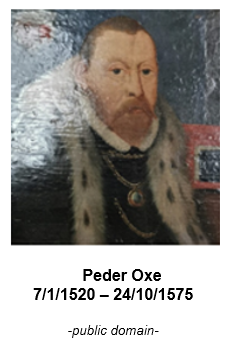
From the beginning the Ochs of Gunzendorf form a branch to the Danish higher nobility – with Peder Oxe they provide the Finance Minister and Imperial Court Master. At that time, he is the richest man in this country[12]. When the Frankish line is to be dying out with Georg Ochs in 1563, Peder Oxe even tries to continue their fiefdom, which, as a Danish family, is not intended in the Holy Roman Empire of German Nation[13].
How closely the two main strands of the Lochners come together shortly before 1500 is shown by the fact that (now it must be anticipated) Henry V’s sons have no descendants in Franconia, because he becomes legal guardian and surrogate father for Pankraz Lochner, who later buys Huettenbach manor. In 1494 he brokers a marriage arrangement between Pankraz Lochner and Helen Ermreicher-Tetzel, a young woman from his mother’s family. He negotiates the large sum of 1000 fl. for his „foster-son“.
In Franconia, on May 2, 1501, on one of the first days of knighthood of the Franconian Chivalry, Pankraz Lochner of Huettenbach will take part for the “red Lochner branches” and Henry V Lochner of Waischenfeld, as the eldest of the family, is the representative, for the first and last time, of the “blue Lochner branches”[14]. A brother of this Henry V named Ulrich is a priest in Bamberg[15], but so far there has been no trace of his brother Conrad V Lochner.
For a long time it is a mystery what becomes of him – then the sensational surprise: in 1466 he is working as a mercenary captain in the service of Emperor Frederic III (House of Habsburg) against the Turks[16], before that he has longer stayed in Lower Bavaria, because there he marries Dorothea of Radlkofen, who is part of a lower aristocratic family from the area around Landshut. His descendants hold high offices at the Habsburg court…
There are indications that other Lochners hire themselves out as mercenaries who cannot be assigned to any line, such as Lucas Lochner[17], who is resident in Achdorf (today’s part of the city of Landshut) and to whom the well-known “robber barons” Conrad Schott of Schottenstein owes a horse – this man is an old friend of Goetz of Berlichingen, the man with the iron fist, a notorious knight. Germany’s most excellent poet laureate, John Wolfgang of Goethe, will immortalize him centuries later!
Now the question still arises as to why Conrad Lochner is going to Carinthia, today the Austrian federal state. It is not uninteresting to know that the Archdiocese of Bamberg was additionally endowed with plenty of property by Emperor Henry II and his wife Kunigunde when it was founded in 1007, including in what was then the Duchy of Carinthia, i.e. these are sources of income that increased its viability in the Middle Ages guaranteed, such as customs duties, tolls and mining revenues. These include the cities of Villach, Feldkirchen and Wolfsberg in the Upper Lavanttal.
Conrad Lochner has been appointed “Vitzdom” (= vice governor) of the Carinthian possessions of the Bamberg bishop around 1463 (StA BA A91, Lade 443 Nr. 396, Doc #13). Because in connection with the so-called “Wunderburg” (Wonder-castle), which was built around 1350, as a stately, huge estate, contemporaries consider it a wonder, which adequately explains the name. Today this is a district of the city of Bamberg, as a large section of the population settled there soon after the “Wunderburg“ was built. The builder is the episcopal forester Friedrich von (Frederick of) Rotenstein. Rotenstein Castle is mentioned in a document in 1349 as a vassal castle of the Higher Nobles of Schluesselberg, already described as “desolate” at that time – located in Burggrub near Heiligenstadt in the valley of the small river of Leinleiter (Bamberg rural district) – built around 1200 as the original home of the Rotensteins, The castle area was first mentioned around 1275, but news about this vassal family is sparse: in 1355 the ruins of Rotenstein Castle are enfeoffed to him, in 1358 his two daughters Gertraud and Anne sold several fields to the monastery of St. Theodore in Bamberg, and in 1361 their above-mentioned father has been appointed knight’s mayor of Bamberg. A brother of Frederick named Conrad dies childless as dean of St. Stephan in Bamberg. It can therefore be assumed that the Rotensteins are extinct from thereon.
Now in documents from Emperor Frederick III (Habsburg) can be found, according to which the “Wunderburg” should have been awarded to the Nobles Veit of Giech and Conrad Lochner in 1463, with a request to the Bamberg Bishop George I (of Schaumberg) in 1465 to do this finally after the death of the former owner Henry Zollner. What is controversial between the Emperor and the Bamberg bishop is that the Emperor sees this fiefdom as a reclaimed Imperial fiefdom (and has evidence of this); his opponent, on the other hand, sees the “Wunderburg”as a district of Bamberg – as his residential city.
Conrad Lochner then personally presents the matter to the Bishop of Bamberg at the beginning of 1465, whereupon the bishop refers him to the Emperor with regard to responsibility. He has already sent Veit of Giech and Conrad Lochner to the Bamberg bishop about the enfeoffment (StA BA A91, Lade 443 No. 396, Doc #6).
About the Noble Veit of Giech at Oberbrunn (today the municipality of Ebensfeld in the Lichtenfels district, Upper Franconia): he is the district judge of the Bamberg monastery until around 1482 (Regesta Imperii XIII H.35 n.169), as has been certainly his father before him, Albrecht of Giech, Bamberg district judge of Carinthia around 1458.
How things ultimately turned out in the case of the “Wunderburg” can only be assumed. The Emperor probably renounces the “Wunderburg” in a personal conversation with the Bamberg bishop in 1471. At the time he has visited Bamberg because of the tax enabling him to finance the fight against the Turks and enhances the favor of the bishop, who had until then been a “friend of the Wittelsbach party” and now turned to the Habsburgs.
The estate finally passes into the hands of the Bishop of Bamberg in 1490. There are currently no further records as to whether Veit of Giech and Conrad Lochner will be compensated with money, which is an option as the bishop bestows the “corpus deliciti” elsewhere. From 1469 onwards, Balthasar of Weisspriach must have become the new Vitzdom (= vice governor) of the Bamberg bishop in Carinthia, from a local noble family, and Conrad Lochner must have switched entirely to the service of the Emperor (StA BA A91, Lade 443 No. 396, Doc #17).
In 1468 Conrad Lochner finally becomes an official in Feistritz – before that, he probably has bought a house in the city center of Wiener Neustadt, at Minoritenviertel (today Bahngasse 17), next to the Emperor’s residence around 1460, because another mercenary captain and comrade-in-arms of him, Florian Winkler of Hainfeld[18] (born ~1420), is doing like him. Both belong to lower knightly families and can purchase a house in Wiener Neustadt (no. 19), which is the prerequisite for obtaining citizenship.
Both mercenary captains have therefore achieved citizenship of Wiener Neustadt[19]. Florian Winkler enters imperial service as early as 1445 until approximately 1472, and, in the meantime seems to have gone to war for Denmark, because on his epitaph there is an order on his armor, i.e. he is a bearer of the Danish Order of the Elephant.
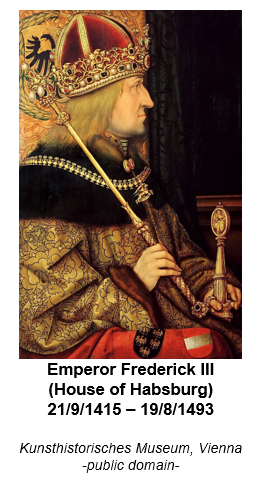
The house of a mercenary captain must have been quite spacious (because, unlike Florian Winkler, Conrad Lochner’s children’s gang probably grows up there), because just for his belongings as a soldier lots of people are working, that includes for example two servants and a stable boy who has to look after several horses, as well as his master’s armory – it contains all the arsenal of weapons such as various crossbows, harnesses and armor[20]. In his will, he dies on September 9, 1477[21], he not only considers members of his own family with his rich inheritance, but Emperor Frederic III being always in financial difficulties, recently has started to practice payment of his own debts by command to rich daughter’s of heirs as to marry one of his numerous vassals. In a letter written by his own secretary’s hand, and even a second warning to Winkler’s family, he determines that Margret Winkler, Florian Winkler’s sister, should immediately take the knight Achaz Mutmannsdoerfer as her husband. The Emperor will even equip the young knight with a lucrative job…[22]

Conrad Lochner of Liebenfels has several children with his wife Dorothea of Radlkofen[23], three sons and three daughters are for certain (see above). What is particularly piquant: one of his sons, Andrew Lochner, will later be appointed provost of one of the monasteries (Eberndorf)[24] from 1532 to 1544, whose freedoms his father has wanted to enrich himself with.
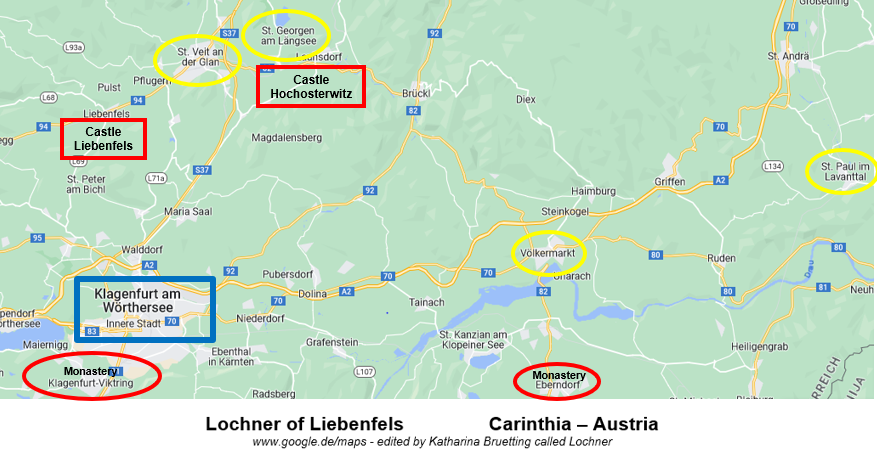
He is quite a choleric character, because there are documents from 1478[25] and again from July 1483[26] in which the Emperor threatens any of his nobles that they would fall “into the gravest disgrace” if they once again violate the rights and freedoms of two Austrian monasteries – these the Emperor addresses in particular to Conrad Lochner[27].
He then receives a pledge from Emperor Friedrich III in 1472 until his death in the second half of 1483 namely the famous Castle Hollenburg[28] as an official in Carinthia, his retirement home[29].
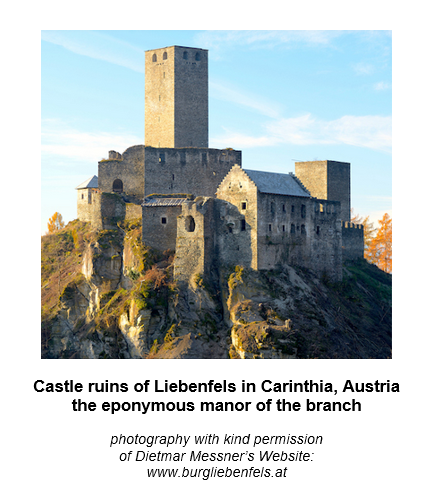
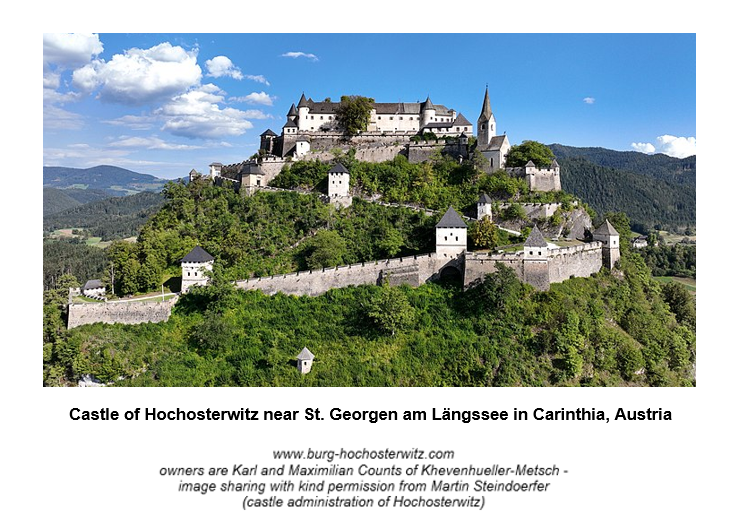
Nothing further is known about the brother of the Eberndorf provost Matthew Lochner[30] (1470 – <1538), except that he is the father of Leonard Lochner and – like his other brother Linhard – he is also a mercenary captain. Linhard Lochner seems to have finally lived in Milan (Condottieri?[31]) via Landshut. At that time, many mercenaries from German gentry are in Italy, where there has been constant war between the city states[32]. And he is handling the inheritance of his cousin, Philipp Lochner, the last Kastner of Waischenfeld.
His distant relative, Dr. jur. utr. John III Lochner of Nuremberg, is in active correspondence at the same time with the Margravine of Mantua, Barbara Gonzaga (born Hohenzollern), and he is advisor to Emperor Frederick III, the Pope and the Duke of Tyrol (see: 03 LVN HISTORY).
In any case, Linhard Lochner, who is considered to have „lived in Milan“[33], fights again – like his father before – as a mercenary captain in 1529 together with his nephew Leonard Lochner against the Ottomans when they besiege Vienna from September 27th to October 14th. In 1536 he buys Liebenfels Castle in Carinthia near St. Veit on Glan from his cousins Ungnad of Weissenwolff and names his Lochner line after it[34]. The Emperor even awards the huge castle and estate of Hochosterwitz to Leonard Lochner before 1521[35]. With him, the historically most famous Lochner line – the Lochner of Liebenfels – extinct in 1570. Leonard Lochner’s heritage is decided by one of his four daughters, Ursula Lochner, married to Louis of Attems[36] (Liebenfels will be sold in 1620).
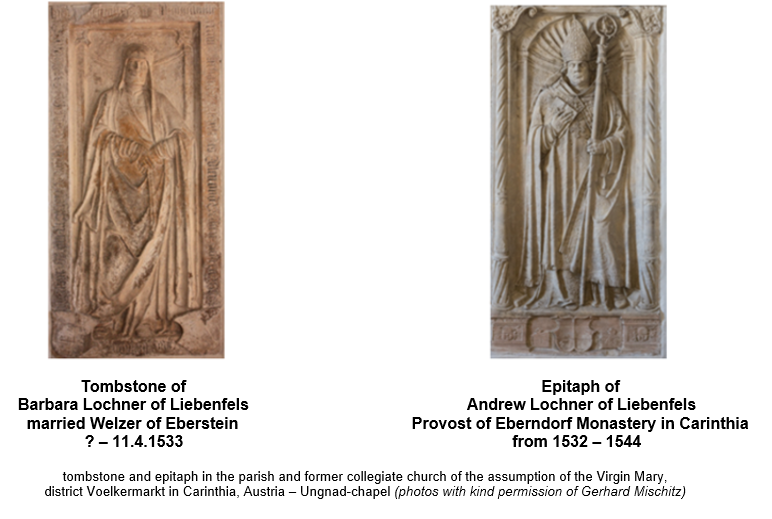
Now the document from October 8, 1538[37] should be reported (see: 02 LVL DATA SHEET):
it clearly proves that the Liebenfels Lochners descend from the Waischenfeld ones. As already mentioned, Henry V Lochner has no descendants, because this line also become extinct in 1538 with his son Philipp Lochner. His inheritance is regulated in the said document and the name Lochner of Liebenfels appears for the first time – and – the name Ungnad of Weissenwolff, Barons of Sonnegg. Concerning the three daughters of Conrad Lochner of Liebenfels(-Waischenfeld), it is proven that Barbara marries into the Welzer of Eberstein family[38], her gravestone has been preserved (see above), and the two others held wedding with the Ungnad of Weissenwolff family. In this document their sister Agnes Lochner is noted only one time and she will make no claims to inheritance. Now the most important Lochner will be introduced: Margret Lochner of Liebenfels.
Born around 1475, she, like her brother Matthew, must have passed away before 1538, because she is not refered to in the document of inheritance of the last Waischenfeld Lochners. She is in relationship with John II Ungnad of Weissenwolff, Baron of Sonnegg, the deputy governor of Styria. His uncle of the same name is a close advisor to Emperor Frederick III (part of the “Styrian Triumvirate”)[39]. His marriage to Richarda of Pernegg has given John I Ungnad access to the royal court. In 1436 he accompanies this future emperor as court marshall on a pilgrimage to the Holy Land when he still has been Duke Frederic V of Austria. This assigns him the office of chamber master, and, he is a counsillor and assessor in chamber court cases. He acquires Sonnegg estate near Voelkermarkt in Carinthia as the eponymous manor of his family in 1442[40].
When John II Ungnad has died in 1521, Margret Lochner instructs her son John III Ungnad, head of the protestant party of Austria and famous within the realm for it, as being an ardent Lutheran living at the court of Queen Mary of Hungary and Bohemia at this time (she is born Habsburg). He is doing his utmost and arranges a position for his mother at the Queen’s court[41]. Mary agrees that his mother, Margret Lochner of Liebenfels, widowed Ungnad of Weissenwolff, should become her Lady High Stewardess[42].
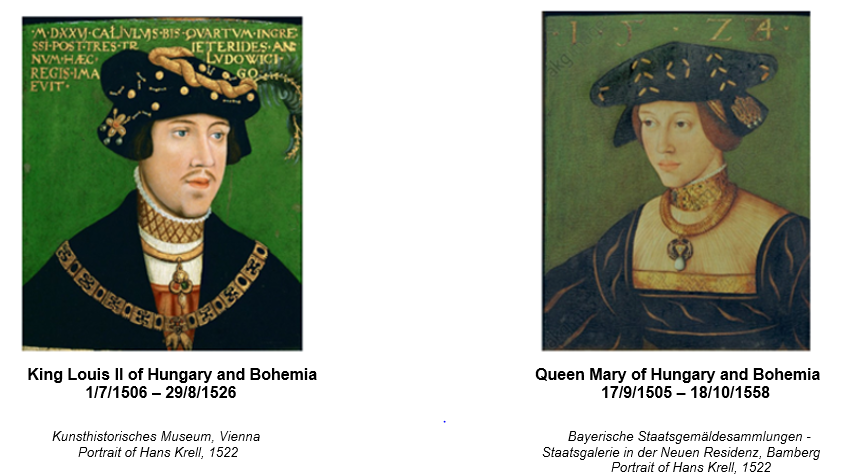
So she becomes “Obriste Hoffmaystarin”[43] (1524 – 1531) with Queen Mary of Hungary and Bohemia – and moves to her court in Buda (now Budapest) with her youngest daughter Elisabeth, who will be working there as a chambermaid. The Habsburg woman must have gotten along brilliantly with “the Lochner women” because she personally invites the Hungarian nobles to the first wedding of Elisabeth Ungnad of Weissenwolff on Thursday, April 15, 1526, with the youngest son of the financiers of the Hungarian royal family, Ferenc Ernuszt of Csaktornya, whose family are converted Jews from Vienna. A few months later he falls in the Battle of Mohacs in 1526, like Louis II of Hungary. After this stroke of fate, Elisabeth has stayed with her mother temporarily and afterwards marries Count Albrecht of Schlick on Winteritz in Bohemia for the second time.
Her sister Barbara Ungnad of Weissenwolff, lady-in-waiting to Anna of Hungary, the wife of Ferdinand I (see below), weds another representative of an important Austrian noble family in 1523: William of Puchheim, Baron of Raabs and Krumbach. And last but not least: a daughter of Margret Lochner is following in her footsteps, Polyxena Ungnad[44]. Because the Habsburgs are ruling both Austria and Spain, several Spanish Catholic aristocrats have been sent to Vienna. Polyxena marries a member of the former Spanish royal family, Don Pedro Lasso de Castilla, Chief Equerry of Ferdinand I and Chief Steward of Emperor Maximilian II. As a widow, Polyxena will also be appointed Lady High Stewardess of Mary of Spain, wife of this emperor.
Her daughter Polyxena Lasso de Castilla y Ungnad’s wedding is to one of the brothers Fernandez de Cordoba y Aguilar, Antonio, whose ancestors have served the „Catholic Kings“ of Spain when defeating the Moors, as does her sister Ana Maria with Diego Fernandez de Cordoba y Aguilar (see 01B LVW/LVL PEDIGREE: Margret Lochner of Liebenfels family tree).
The arrangement of the double wedding of the Habsburgs by Emperor Maximilian I has been a cleverly planned „chess-move“, according to this wise saying afterwards: „Bella gerant alii, tu felix Austria nube“. Mary, his granddaughter, has to marry the heir of the Hungarian king, the Jagiellonian Lajos (Louis II) – conversely, his sister Anna weds Emperor Ferdinand I, who has an extremely friendly relationship with John III Ungnad of Weissenwolff – until the sudden end!

After the devastating Battle of Mohacs, when Hungary is defeated by the Turks, there is a final changing in Margret’s life because Mary of Hungary does not want to let her brothers put her under the hood again. In fact, in June 1528, Emperor Ferdinand I (see above) writes a letter to Margret as to influence and “favor“ his sister Mary for a marriage project with James V of Scotland (1513-1542). This King of the Scots, who has been fighting in the war against his uncle, King Henry VIII of England, finally falls[45]. Mary, who always feels close to her brothers, asks strongly to be appointed governor of the Netherlands, where her aunt Margaret of Burgundy, the daughter of Emperor Maximilian I, formerly has died. To Margret Lochner Mary of Hungary owes 3,582 fl.[46], as she got into serious financial difficulties after the Mohacs battle. By 1530, all of her creditors add up a sum of 18,032 Rhenish guilders[47].
Emperor Charles V agrees in principle but demands that several important personalities of her Hungarian court have to abdicate, especially her Lady High Stewardess Margret Lochner because she is said to be Lutheran-minded, and so he declares her persona non grata. Perhaps he is nervous that Mary of Hungary could become Lutheran too – despite her convenants to the ‘Casa de Austria’? Martin Luther personally translates four psalms for Mary and sends her an emotional letter intended as a consolation after the battle of Mohacs. Mary of Hungary and her brother Ferdinand I never contradict the authority of her brother Emperor Charles V, but when it comes to the question of appointing a new chief steward at Mary’s future court in the Netherlands, he reminds her strongly that local personalities should be considered…[48]
In any case, the search for a successor for Margret Lochner, with whom Mary got along so very well, turns out to be unusually difficult because Mary has a reputation as an “eccentric personality”[49].
E N C L O S U R E:


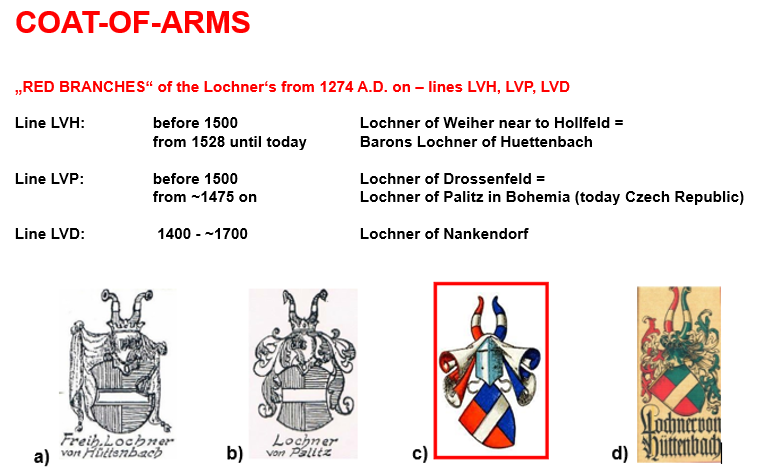



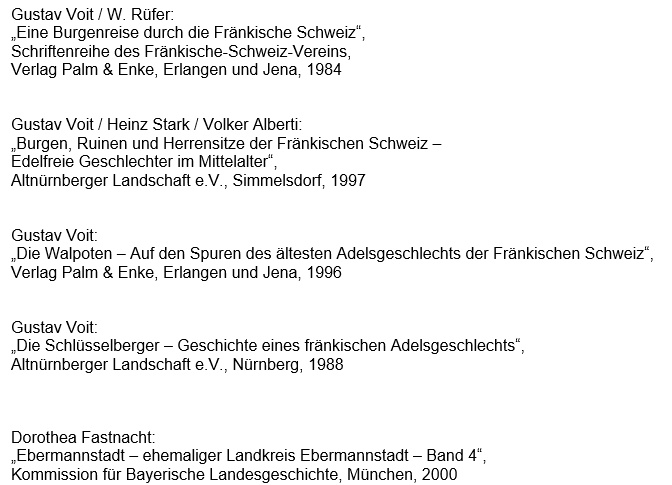
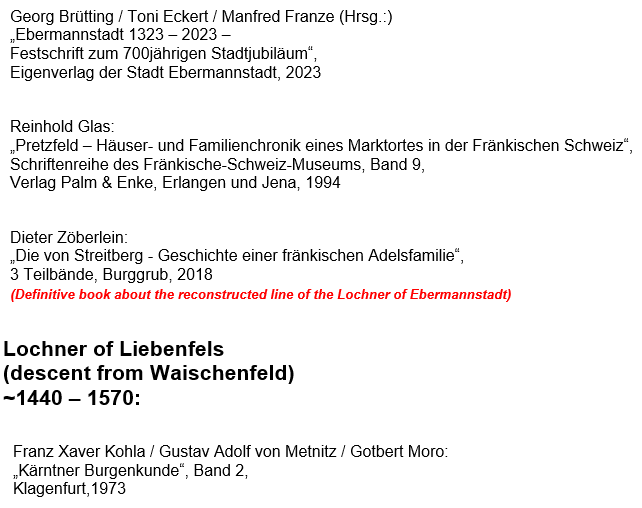


FOOTNOTES:
the books mentioned are in German language but the title of the books – as footnotes – are translated for a better understanding, when possible
-
“Franconian Switzerland” – in German “Fraenkische Schweiz“ – is a picturesque landscape between the cities of Bamberg, Bayreuth and Nuremberg, well known for its castles, mills and caves ↑
-
Oldest fief-book of Wuerzburg Monastery (Hochstift), 1st volume of 1303 – 1354, p. 187, notices nos. 1778 und 1779 ↑
-
Hellmut Kunstmann: „Castles of Eastern Franconian Switzerland“, commission publishers Ferdinand Schoeningh, Wuerzburg, 1965, p. 51 ↑
-
StA BA Stb. 3, p. 33 at Forchheim (StA BA = State Archives of Bamberg) ↑
-
Imperial District Court Bamberg = LGB, no. 921, fol. 154b (ex complaint-book, fol. 92) and LGB, no. 904, fol. 12b (ex complaint-book, fol. 154b) ↑
-
Kastner = tithe keeper of a certain district ↑
-
StA BA Rep. A205/4 no. 7619 L. ↑
-
StA BA Stb. 3, fol. 118 – lending of the fiefdom to John II of Rabenstein ↑
-
StA BA Stb. 4, fol. 90 – purchase by Conrad of Wirsberg senior at Unterailsfeld ↑
-
Gustav Voit: „The Rabensteins – the career, fate and end of an important knightly family in Franconian Switzerland“, Altnürnberger Landschaft e.V., Simmelsdorf, 1998 – p. 17 and 78
In 1460 Wolfram of Rabenstein inherited the remaining share of the third castle estate in Oberntuechersfeld. His brother George III of Rabenstein (1446 – 1482), married to Elsbet Hilpoltsteiner, is the owner of Huettenbach Castle at this time (State archives of Nuremberg, Rep. 311, Lochner Archives, document 7). The Huettenbach manor near Simmelsdorf has been bought in 1528 by Pankraz Lochner, after whom his descendants, the Barons of Lochner, still name themselves until today. Pankraz’s guardian is Henry V Lochner of Waischenfeld, his guardian and „foster father“ – a distant relative. ↑
-
Hellmut Kunstmann: „Castles of Eastern Franconian Switzerland“, comission publishers Ferdinand Schoeningh, Wuerzburg, 1965 ↑
-
„Peder Oxe’s live og levuet“ – Copenhagen: 1675 , Danmarks riges historie, vol. 3, Copenhagen: 1897-1905 – with kind advice by Steen Thomsen (being a descendant of the Oxe himself)) ↑
-
Danish National Museum – www.kongegrave.dk – the painting of Peder Oxe is also hanging there ↑
-
Pamphlet of Baron Maximilian Lochner of Huettenbach – Line of Elten – on the subject: „The Lochner of Loch, Wiesentfels and Weiher near Hollfeld“ – dedicated to the memory of his ancestors, Lindau, 1935 – no documents acquainted ↑
-
He is admitted to minor orders in Bamberg as a clergyman on 13.4.1465. He studies in Leipzig since the winter semester 1465 –
in: „General-Personal-Schematismus der Erzdiözese Bamberg 1007 – 1907“, Hrsg: Friedrich Wachter, Druck von Johann Nagengast, Bamberg, 1908 ↑ -
F.X. Kohla, G.A. von Metnitz, G. Moro: „Kärntner Burgenkunde“, Band 2, Klagenfurt 1973, S. 95f. – Horst Gehringer (Director of the city archives of Bamberg): „Die Wunderburg in Bamberg“, Vol. 1, Bamberg, 2005 – Horst Bielmeier/Klaus Rupprecht (Editors): „Gift for Gerd Zimmermann 65th Birthday“, Supplement #23, Bamberg Historical Association, H.O. Schulze Publishers, Lichtenfels, 1989 – pp. 111 – 138↑
-
Dr. G.W.C. Lochner, Co-founder of the Nuremberg City Archives. He mentions this in his folder #40, p. 54 from Oct.. 1532, Cons. 44 Fol. 35b ↑
-
Relationship of the Lochners with the Winklers: The granddaughter of Rochus Lochner von Huettenbach, daughter of his older son, named Sophia Susanna (May 20, 1650 – 1723) married Heinrich Lothar Winkler of Hainfeld from Schlackenwerth in Bohemia around 1670 – i.e. this family forms, like the Lochner
,a side line to Bohemia. ↑ -
Purchase of house number 19 by Florian Winkler of Hainfeld, located between the houses of “Conradi Lochner and Thoman Holapetzl“ – Josef Mayer: „History of Wiener Neustadt“, part II, Wiener Neustadt, 1926, p. 511, notice 1 – Bahngasse 17: recently there has been the „Leiner furniture department store“ in Wiener Neustadt, now the new „Maximilium at the city park“ is scheduled to be built by 2026. The house is close to the city wall, directly to the castle, the residence of Emperor Frederick III – according to a kind advice of Dietmar Messner. Conrad Lochner acquires another house in Wiener Neustadt on October 21, 1466, which previously belonged to knightly families, State Archives of Wiener Neustadt – historical volume 573 ↑
-
Citation of an article of the recently deceased Dr. Gertrud Buttlar-Elberberg, Austria – Verein für Landeskunde von Niederösterreich: www.noe.gv.at/noe/LandeskundlicheForschung/Verein_Landeskunde.html – former director of the City Archives of Wiener Neustadt ↑
-
Testimony of Florian Winkler of Hainfeld from September 9, 1477 at the State Archives of Wiener Neustadt, Austria, council-book II („Ratsbuch“), fol. 239r ↑
-
Josef Chmel: „Auszüge aus einem Kanzleibuche (Conzepten-Sammlung König Friedrichs IV. vom Jahre 1478)“, in: Notizenblatt, Beilage zum Archiv für Kunde österreichischer Geschichtsquellen, 2. Jahrgang, Vienna, 1852, p. 361 – no. 471 ↑
-
State Archives of Carinthia, Austria – Ständisches Archiv, document AT-KLA 457-B-531 St ↑
-
Archives of Sankt Paul im Lavanttal, Austria – Stiftsarchiv Urkunden, Stift Eberndorf 105 ↑
-
State Archives of Carinthia, Austria – general series of documents: AT-KLA 418-B-C 2982 St – the monastery of Viktring at Klagenfurt is meant ↑
-
Copy at the Main State Archives of Vienna, Austria – Signature AUR 1483 VII 21, Pap. (18th century) ↑
-
Conrad Lochner of Liebenfels is said to be the 14/15th great-great-grandfather of the European kingdoms: fabpedigree.com/s014/f107889.htm ↑
-
Regesta Imperii, Main State Archives of Vienna, Austria – document no. 32494/ Fr. III Urk. DB ↑
-
F.X. Kohla, G.A. von Metnitz, G. Moro: Kärntner Burgenkunde, Band 2, Klagenfurt 1973 – there are several documents existing of him as an officer ↑
-
Matthew Lochner of Liebenfels is the uncle by marriage of William Puchheim, that means the uncle of his wife Barbara Ungnad of Weissenwolff – www.kaiserhof.geschichte.lmu.de – KH 12874 and 11816 (Ludwig-Maximilian-University Munich – LMU) ↑
-
Condottieri: name for a mercenary captain in Italy around 1500 ↑
-
www.wikipedia.de – i.e. Julian Romane: „The First & Second Italian Wars, 1494–1504: Fearless Knights, Ruthless Princes & the Coming of Gunpowder Armies. Pen and Sword Military“, Yorkshire-Philadelphia, U.S.A, 2020 ↑
-
City Archives of Nuremberg, inheritance of Dr. G.W.C. Lochner – Cons. 79, Fol. 208, file 36 of Augst 5,1552 ↑
-
www.burgen-austria.com – today’s owner of the castle ruin is Dietmar Messner, Wiener Neustadt, Austria ↑
-
State Archives of Carinthia, Austria: Bestand Khevenhüller, AT-KLA 649-C-14 Ak ↑
-
State Archives of Carinthia, Austria: St. Georgen am Längsee II, AT-KLA 443-B-26 St – Leonard Lochner has four daughters from his marriage to Margarethe of Metnitz: only Anastasia Lochner is known by name ↑
-
State Archives of Carinthia, Austria: AT-KLA 457-B-90 F St ↑
-
Monika Stumberger: “The Welzer – genealogy and property history of a Styrian noble family”, dissertation at Graz University, 1980 ↑
-
“Styrian Triumvirate” = John II of Neitperg, steward, his relative Walther Zebinger and chamberlain John I Ungnad form the councilors of Emperor Frederick III – Piccolomini coins this term, which is meant ironically – Paul-Joachim Heinig: “Emperor Frederick III (1440 – 1493) in his time“, in: Studies on the 500th anniversary of his death on August 19, 1493/1993 (= research on the history of emperors and popes in the Middle Ages, Volume 12) – Boehlau, Cologne and others 1993, see volume 3, register p. 1776 ↑
-
Paul-Joachim Heinig: “Emperor Friedrich III (1440 – 1493) in his time“ (see footnote 126 there) – volume 1, p. 178 ↑
-
Gernot Heiss: “Politics and Advicers”, p. 17 – András Kubinyi: „The Court of Queen Mary”, p. 16 ↑
-
steward/stewardess in the Middle Ages act as the immediate head of the imperial court and household ↑
-
MOL Dl 24279 (Magyar Országos Levéltár, Diplomatikai levéltár, Hungary) this is how Margret Lochner of Liebenfels is addressed to in the marriage agreement written in German between her youngest daughter Elisabeth Ungnad of Weissenwolff, Baroness of Sonnegg, and her first husband, Ferenc Ernuszt of Csaktornya – also stated in the wedding invitation from Mary of Hungary to Prince Ferenc Batthyány: Ed. Béla Iványi, “Memorabilia from the archive at Körmend”, 1942, no. 204 ↑
-
Gernot Heiss: “Mary of Hungary”, p. 440 and in Spanish language on the blog – http://palomatorrijos.blogspot.com/2011/03/antonio-domingo-fernandez-de-cordova_22.html ↑
-
Biografia.sabiado.at/Lochner-von-Liebenfels – authoress of the biography: Ingrid Roitner, Austria – James V. of Scotland is the father of Mary Stuart ↑
-
Main State Archives of Vienna, Austria – family files 97: List of the debts of Mary of Hungary (Augsburg, November 15, 1530) – Gernot Heiss: „Politics and Advisers“, p. 170 ↑
-
Orsolya Rethelyi: „Mary of Hungary in Court Context, 1521 – 1531”, p. 123 – Karl Lanz: “Correspondance of Emperor Charles V., vol. I, 416 ff. ↑
-
Herwig Wolfram et al., eds.: „Correspondance of Mary of Hungary with her brother Emperor Ferdinand I“, letter of July 27, 1531 (Brussels – vol. 3, no. 523) and letter of January 24, 1531 (Krems – vol. 3, no. 450) ↑
-
Main State Archives of Vienna, Austria (concept – Belgium PA, fol. 166 – 169): “Letter of Mary of Hungary to her brother Emperor Ferdinand I” of June 2, 1540 – Gernot Heiss: „Mary of Hungary“, p. 448 ↑